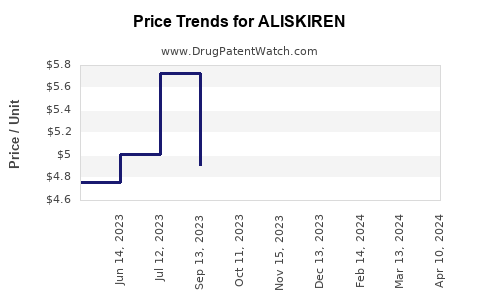Drug Price Trends for ALISKIREN
✉ Email this page to a colleague

Average Pharmacy Cost for ALISKIREN
| Drug Name | NDC | Price/Unit ($) | Unit | Date |
|---|---|---|---|---|
| ALISKIREN 300 MG TABLET | 49884-0425-11 | 5.51677 | EACH | 2024-11-20 |
| ALISKIREN 300 MG TABLET | 66993-0142-30 | 5.51677 | EACH | 2024-11-20 |
| ALISKIREN 150 MG TABLET | 49884-0424-11 | 4.30682 | EACH | 2024-11-20 |
| ALISKIREN 150 MG TABLET | 66993-0141-30 | 4.30682 | EACH | 2024-11-20 |
| ALISKIREN 150 MG TABLET | 66993-0141-30 | 4.42913 | EACH | 2024-10-23 |
| >Drug Name | >NDC | >Price/Unit ($) | >Unit | >Date |
Best Wholesale Price for ALISKIREN
| Drug Name | Vendor | NDC | Count | Price ($) | Price/Unit ($) | Unit | Dates | Price Type |
|---|---|---|---|---|---|---|---|---|
| ALISKIREN 150MG TAB | Prasco, LLC | 66993-0141-30 | 30 | 92.54 | 3.08467 | EACH | 2021-07-01 - 2026-06-30 | Big4 |
| ALISKIREN 300MG TAB | Prasco, LLC | 66993-0142-30 | 30 | 108.32 | 3.61067 | EACH | 2023-01-01 - 2026-06-30 | Big4 |
| ALISKIREN 150MG TAB | Prasco, LLC | 66993-0141-30 | 30 | 177.23 | 5.90767 | EACH | 2021-07-01 - 2026-06-30 | FSS |
| ALISKIREN 300MG TAB | Prasco, LLC | 66993-0142-30 | 30 | 98.40 | 3.28000 | EACH | 2024-01-01 - 2026-06-30 | Big4 |
| ALISKIREN 150MG TAB | Prasco, LLC | 66993-0141-30 | 30 | 85.30 | 2.84333 | EACH | 2023-01-01 - 2026-06-30 | Big4 |
| >Drug Name | >Vendor | >NDC | >Count | >Price ($) | >Price/Unit ($) | >Unit | >Dates | >Price Type |


